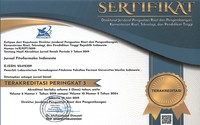EFEK HEPATOPROTEKTOR ANDROGRAPHOLIDE TERHADAP AKTIVITAS ALANIN AMINOTRANSFERASE DALAM SERUM Rattus norvegicus JANTAN GALUR WISTAR YANG DIINDUKSI KARBON TETRAKLORIDA
Abstract
Background: Andrographolide is a diterpenoid bioethanol that effectively prevent liver injury by reducing liver oxidative stress response. Method : The research was randomized experimental design with pretest-posttest design. Thirty male wistar rats was randomly divided into 6 groups, normal control, negative control (0,2 ml CCl4), and positive control (500 mg/kgBW curcumin), dose I (50 mg/kgBW), dose II (100 mg/kgBW), dose III (200 mg/kgBW) given for 8 days and induced by 0,2 ml CCl4 on the first day. Data was analyzed by One-Way Anova test, LSD Post-Hoc test and paired T test. Results :All groups induced by CCl4 shows elevated of ALT activity. The posttest results shows significant differences of ALT activity between groups (p<0,05). Conclusion : Andrographolide shows hepatoprotector effect by decrease the activity of ALT in male wistar rats induced by CCl4. The effective dose of andrographolide is 200 mg/kgBW.
Keywords
Full Text:
PDF (Bahasa Indonesia)References
Adewale O.B, Adekeye A.O, Akintayo C.O, Onikanni A, S. S. (2014) ‘Carbon tetrachloride (CCl 4 )-induced hepatic damage in experimental Sprague Dawley rats: Antioxidant potential of Xylopia aethiopica’, The Journal of Phytopharmacology, 3(2), pp. 118–123.
Chao, W.-W. and Lin, B.-F. (2010) ‘Isolation and identification of bioactive compounds in Andrographis paniculata (Chuanxinlian)’, Chinese Medicine, 5(1), p. 17. doi: 10.1186/1749-8546-5-17.
Dai, N. et al. (2014) ‘Antioxidant Properties of Proanthocyanidins Attenuate Carbon Tetrachloride (CCl 4 )–Induced Steatosis and Liver Injury in Rats via CYP2E1 Regulation’, Journal of Medicinal Food, 17(6), pp. 663–669. doi: 10.1089/jmf.2013.2834.
Daniel, S. et al. (2004) ‘Through metal binding , curcumin protects against lead- and cadmium-induced lipid peroxidation in rat brain homogenates and against lead-induced tissue damage in rat brain’, 98, pp. 266–275. doi: 10.1016/j.jinorgbio.2003.10.014.
Departemen Kesehatan RI (2007) Pharmaceutical Care untuk Penyakit Hati. Jakarta: Departemen Kesehatan RI.
Fujii, T. et al. (2010) ‘Mouse model of carbon tetrachloride induced liver fibrosis: Histopathological changes and expression of CD133 and epidermal growth factor’, BMC Gastroenterology, 10(1), p. 79. doi: 10.1186/1471-230X-10-79.
Gold, E. J. et al. (2003) ‘Changes in activin and activin receptor subunit expression in rat liver during the development of CCl4-induced cirrhosis’, Molecular and Cellular Endocrinology, 201(1–2), pp. 143–153. doi: 10.1016/S0303-7207(02)00417-3.
González-Reyes, S. et al. (2013) ‘Curcumin pretreatment induces Nrf2 and an antioxidant response and prevents hemin-induced toxicity in primary cultures of cerebellar granule neurons of rats’, Oxidative Medicine and Cellular Longevity, 2013. doi: 10.1155/2013/801418.
Hu, H. Z. et al. (2011) ‘Protective Mechanism of Andrographolide against Carbon Tetrachloride-’, 34(11), pp. 1666–1670.
Khedr, N. F. and Khedr, E. G. (2014) ‘Antioxidant and Anti-inflammatory Effects of Curcumin on CCl4 â?" induced Liver Fibrosis in Rats’, American Journal of Biomedical Sciences, 6(3), pp. 191–200. doi: 10.5099/aj140300191.
Kumar, V., Abbas, A. K. and Aster, J. C. (2013) Buku Ajar Patologi Robbins. 9th edn. Edited by I. Nassar and S. Cornain. Jakarta: Elsavier.
Marinda, F. D. (2014) ‘Hepatoprotective effect of curcumin in chronic hepatitis’, J Majority, 3(VII), pp. 52–56.
Panjaitan, R. G. P. et al. (2007) ‘Pengaruh Pemberian Karbon Tetraklorida Terhadap Fungsi Hati Dan Ginjal Tikus’, Makara, kesehatan, 11(1), pp. 11–16.
Ratner, M. H. et al. (2008) ‘The Current State of Serum Biomarkers of Hepatotoxicity The current state of serum biomarkers of hepatotoxicity’, (April). doi: 10.1016/j.tox.2007.11.021.
Sherwood, L. (2014) Fisiologi Manusia Dari Sel Ke Sistem. 8th edn. Edited by H. O. Ong, A. A. Mahode, and D. Ramadhani. Jakarta: EGC.
Sonderup, M. W. (2011) ‘[Drug induced liver injuries].’, Canadian Medical Education Journal, 29(6), pp. 244–246. Available at: http://www.ncbi.nlm.nih.gov/pubmed/22841776%5Cnhttp://www.ncbi.nlm.nih.gov/pubmed/8231072.
Torotra, G. J. and Derrickson, B. (2014) Principles of Anatomy and Physiology. 14th edn. Hoboke: WILEY.
Visen, P. K. S. et al. (1993) ‘Andrographolide protects rat hepatocytes against paracetamol-induced damage’, Journal of Ethnopharmacology, 40(2), pp. 131–136. doi: 10.1016/0378-8741(93)90058-D.
Zhang, Z. et al. (2012) ‘Protective effect of andrographolide against concanavalin A-induced liver injury’, Naunyn-Schmiedeberg’s Archives of Pharmacology, 385(1), pp. 69–79. doi: 10.1007/s00210-011-0685-z.
DOI: https://doi.org/10.33096/jffi.v8i1.582
Copyright (c) 2021 Dewinta Putri Utami, Andriani Andriani, Mardhia Mardhia, Virhan Novianry, Mistika Zakiah

This work is licensed under a Creative Commons Attribution-ShareAlike 4.0 International License.
Indexed by:
ISSN: 2356-0398 | e-ISSN: 2541-2329
Editor's Address:
Third Floor Pharmacognosy-phytochemistry laboratory building, Urip Sumoharjo road km. 5 Campus II UMI, Makassar, South Sulawesi, Indonesia
Phone: +6281524045514
Fax: +62411425619
E-mail: editorjfi@umi.ac.id

















.jpg)

